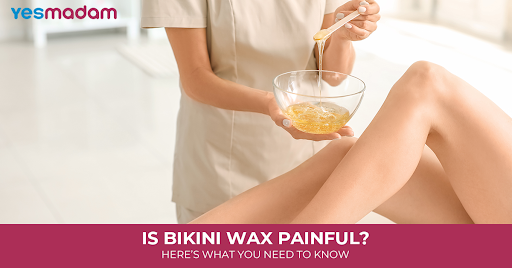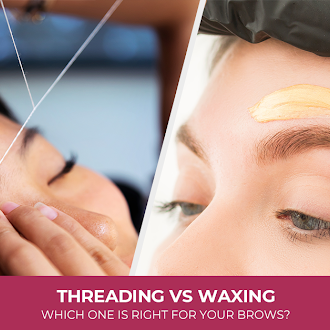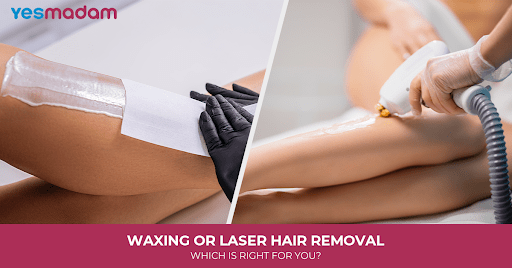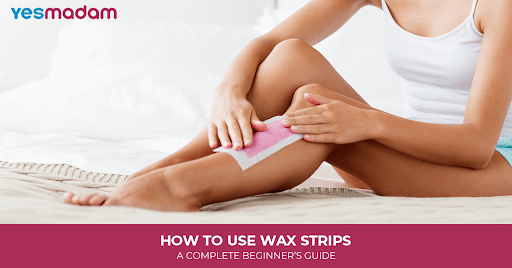
Is Bikini Wax Painful? Here’s What You Need to Know
Waxing is a convenient technique to root out public hair. Among many waxing techniques available, a bikini wax is the most effective way to remove public hair.
But there is one concern, The Pain. However, the good news is, there are several tips to make bikini waxing less painful.
Keep reading to clear your doubts on is bikini wax painful? Along with expert-backed tips on preparing your skin and minimizing discomfort. This will help you book your bikini wax appointment with confidence and ease.

Table of Contents
What is a Bikini Wax?
The most precise definition of a bikini wax is to remove the hair outside the panty line. This type of wax removes hair along and outside of your bikini line. In other words, anything that might be visible outside your underwear or bathing suit.
The wax used can be cold or hot, which adheres to the hairs and pulls them out quickly from the skin with a cloth strip. The end goal is to provide you with a neat, tidy look when wearing a bikini, swimsuit, or underwear.
How to Prepare for a Bikini Wax – Tips and Facts
For waxing without pain, here are the important prep tips that you need to consider:
- Find a reputable salon through good research. Don’t settle for anything less than a clean and professional salon. Referrals through friends and relatives are often the best way to know about the right salon.
- Go for waxing when you don’t have your period. While you can get a wax done during periods, most experts do not recommend it, especially if you are waxing for the first time.
- Do not exfoliate a few days before: Experts recommend doing light exfoliation a couple of days before waxing. This will help to keep your skincare routine gentle and avoid anything harsh on your skin that might cause redness and irritation after the wax.
- Consider taking a painkiller on the waxing day: Pain is the main fear factor for those undergoing bikini wax for the first time. Taking painkillers 30-45 minutes before the appointment can help reduce pain.
- Delay waxing if you have short-term skin problems: Schedule your appointment again to let the sunburn and other skin irritation clear up. This will help avoid extra irritation or pain during and after the waxing session.
- Wear loose-fitted clothes: Don’t wear leggings and tight skinny jeans, and attend your waxing appointment in something a little lighter and looser. This will help prevent friction in the waxed area, like wax burn afterward.

Tips on How to Reduce Pain During Waxing
Here’s a detailed pre-waxing, during the waxing, and after the waxing tips on how to reduce waxing pain.
Here’s a more detailed breakdown of the tips on how to reduce wax pain:
Before the Waxing:
1. Take a Pain Reliever: Taking an over-the-counter pain reliever like ibuprofen or Tylenol about 30-60 minutes before your appointment can help reduce pain during the procedure.
2. Use a Numbing Cream: Applying a numbing cream containing lidocaine to the area at least 30 minutes before waxing can help to dull the sensation of pain.
3. Avoid Caffeine and Alcohol: These can increase skin sensitivity, so it’s best to avoid them on the day of your waxing appointment.
4. Hydrate Well: Staying hydrated can make your skin more pliable, which might reduce discomfort during waxing.
5. Exfoliate: Exfoliating the area a day or two before waxing can help remove dead skin cells and allow the wax to better grip the hair.
6. Avoid Shaving: Avoid shaving the area between waxing appointments, as shaving can make the hair shorter and more difficult to wax, potentially causing more pain.
During the Waxing:
1. Warm Bath/Shower: Taking a warm bath or shower before waxing can help soften the hair follicles and make the process less painful.
2. Breathe Deeply: Relaxing and breathing deeply can help you cope with the pain during the waxing.
3. Turn Your Head and Cough: Turning your head and coughing when the wax is removed can be a distraction from the pain.
4. Stay Relaxed: Being tense during a wax can actually increase the pain, so try to stay relaxed throughout the procedure.
After the Waxing:
- Sooth the Skin: After waxing, apply a soothing product like aloe vera or chamomile lotion to calm the skin.
- Wear Loose Clothing: Avoid tight clothing for the first 24-48 hours to prevent irritation.
- Avoid Hot Showers and Sun Exposure: Hot showers and sun exposure can also irritate the skin, so it’s best to avoid them for a day or two after waxing.
Which Waxing Method is the Least Painful? Pain Guide by Wax Type
The following is a detailed table on various types of wax and their pain levels to help you select the most suitable hair removal option.
| Wax type | Description | Best used for | Pain level | Skin type suitability |
| Hard wax | Thick application, hardens on the skin, no strips used during removal. | Face, bikini, underarms, and sensitive areas. | Low-medium | Dry, sensitive skin. |
| Soft wax ( strip wax) | Thin layer application, removal with cloth strips. | Arms, legs, and large areas. | Medium -high | Normal, oily skin |
| Sugar wax ( sugaring ) | A mix of sugar, lemon, and water adheres to hair, not skin. | All areas ( even sensitive parts ) | Low-medium | All skin types |
| Cream wax | Thicker consistency, used with strips. | Legs, arms, chest | Moderate | Best for sensitive and dry skin. |
| Cold wax | Pre-applied strips, used without heating. | Upper lip, arms, travel-friendly. | High | Normal skin |
| Aloe vera wax | Aloe vera provides a calming effect. | Underarms, bikini. | Very low. | Highly sensitive/irritated skin. |
More Information For You: Wax Powder for Hair Removal
Conclusion
So, is bikini wax painful? Yes, usually. As there are more nerves around your genital area, according to experts. But the pain level ranges between medium to low. Follow the above-mentioned pre, during, and post-waxing tips to lessen wax pain and achieve flawless skin.
In the end, the best precautionary step is to mentally prepare yourself and try to stay relaxed. Don’t rely on cheap DIY bikini waxes!. Unless you are highly trained at DIY bikini waxes at home, it’s best to go to a professional salon for safer results.
FAQs
How painful is brazilian bikini wax?
A Brazilian wax is usually painful, although the level of pain varies from person to person, and factors like your pain tolerance, skin sensitivity, and the hair thickness.
Is peel off wax painful?
No, peel off wax is normally less painful as it is not about pulling hair with a strip as in regular waxing, but peeling -off the gel-like wax itself.
Is roll on wax less painful?
Yes, roll on wax is less painful, especially on larger, sensitive areas like arms and legs. It’s a great choice for beginners and for those looking for a cleaner, quicker experience.
Is waxing very painful?
Yes, waxing can be painful, but how painful it feels varies from person to person. A sharp, brief, painful sensation can be felt when the wax strip is pulled, leaving the skin red and sensitive for 1-2 days.
What are the tips to reduce bikini wax pain?
To minimize the bikini wax pain, following pre- and post-waxing steps can be useful. For example, taking a pain reliever, gentle exfoliation, and wearing loose-fitting clothing.
What is a bikini full wax and a bikini line wax?
A bikini line removes hair only along the bikini line. While a full bikini wax removes hair from the bikini line, the sides, and potentially the top or any hair beneath the belly button.
Which wax type is painless for bikini area?
For a less painful bikini wax, hard wax is preferred. It adheres to the hair, not to the skin, thereby reducing irritation and friction.
How long does a bikini wax usually last?
A bikini wax lasts for 3-4 weeks, but it can vary as per individual hair growth cycle and the frequency of waxing.
Is bikini wax safe for you?
Yes, bikini waxing is safe when performed by a trained expert using correct methods and high-quality products.
Does bikini wax cause pimples?
Yes, bumps or pimples appear after a bikini wax. This happens due to inflammation or folliculitis, which causes small, round bumps looking like acne.



